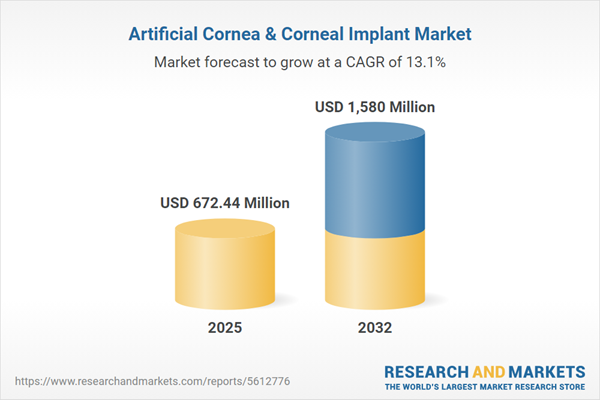Speak directly to the analyst to clarify any post sales queries you may have.
The artificial cornea and corneal implant market is advancing steadily as healthcare organizations emphasize improving vision restoration, efficiency, and access for patients worldwide. Continuously evolving technologies and collaborative industry approaches are setting new standards across global markets.
Market Snapshot: Artificial Cornea & Corneal Implant Market
The artificial cornea and corneal implant market is experiencing dynamic growth, supported by significant investments and strengthened by numerous partnerships among manufacturers and technology innovators. These factors are accelerating technology adoption across synthetic and biosynthetic implant types. New alternatives are enabling greater independence from donated tissue, directly enhancing clinical results and optimizing patient satisfaction. Industry collaboration increasingly drives advances that overcome regulatory hurdles, resulting in more reliable products and improved standards of care. Together, these trends are broadening global access to advanced ocular therapies and raising the quality of treatments in priority healthcare markets.
Scope & Segmentation of the Artificial Cornea and Corneal Implant Market
This in-depth market overview provides essential segmentation guiding executive decision-making, supporting precise investment and targeted growth:
- Product Types: Includes allografts, biosynthetic corneas, integrated keratoprosthesis, nonintegrated keratoprosthesis, and xenogeneic corneas, giving clinicians tools to tailor care for complex ocular cases.
- Material Types: Features collagen, decellularized tissue, hydrogels, and polymethylmethacrylate (PMMA) to meet compatibility and long-term performance needs.
- Application Areas: Encompasses cosmetic, optical, and therapeutic uses, offering solutions for vision enhancement and recovery from advanced corneal complications.
- End Users: Serves hospitals, ambulatory surgery centers, eye clinics, and research institutions that validate and introduce new implant solutions.
- Distribution Channels: Covers direct sales, distributor models, and e-commerce platforms, enabling accessible procurement for different healthcare environments.
- Technologies: Incorporates nanotechnology, tissue engineering, synthetic polymers, 3D bioprinting, and cell seeding, supporting long-lasting integration and functional innovation in implant development.
- Regional Coverage: Spans the Americas, Europe, Middle East, Africa, and Asia-Pacific, highlighting critical regulatory strategies and market trends in regions including the US, Canada, China, India, and Japan.
- Key Industry Participants: Lists Bausch + Lomb Incorporated, Mediphacos S.A., AcuFocus Inc., ReVision Optics Inc., FCI Ophthalmics Inc., CorNeat Vision Ltd., and EyeYon Medical Ltd., all contributing to the developing competitive environment.
This segmentation assists senior leaders in aligning commercialization, regulatory preparedness, and product innovation with diverse geographic and clinical demands.
Key Takeaways for Senior Decision-Makers
- Enhanced manufacturing and supply chain flexibility allow businesses to adapt to changing clinical and product requirements effectively.
- Adoption of synthetic polymers and nanotechnology increases implant resilience, building trust among medical staff and recipients.
- Combining clinical, regulatory, and market expertise quickens commercialization timelines and creates additional market entry opportunities.
- Integrating drug-delivery technologies supports quicker recovery after surgery while promoting long-term patient wellbeing.
- Customized market strategies accommodate varied regional policies, helping organizations navigate regulatory landscapes and maximize reach.
- More rapid regulatory review processes contribute to earlier adoption of new corneal solutions, helping systems keep pace with changing patient needs.
Tariff Impact on Supply Chain Dynamics
With upcoming changes in United States tariff policy in 2025, companies within the artificial cornea and corneal implant market are proactively reviewing their supply chain strategies. Emphasis is now on reinforcing local supplier relationships and expanding vertical integration, particularly in high-value areas such as 3D bioprinting and cellular engineering. These steps are important to maintaining the pace of research and development and ensuring ongoing market competitiveness despite evolving regulatory demands.
Methodology & Data Sources
This market analysis is based on interviews with ophthalmic surgeons, biomaterials experts, regulatory authorities, and procurement professionals. The research combines these insights with peer-reviewed literature, patent tracking, and updates from recognized organizations to deliver validated and actionable guidance.
Why This Report Matters
- Enables executive leadership to implement clear technology assessments and strategically prioritize investments for strong business outcomes in the artificial cornea and corneal implant sector.
- Delivers timely updates on regulatory and innovation pipelines for more informed, proactive executive management.
- Explains the impact of biomaterial advances and regulatory factors on risk management and growth, supporting future-oriented planning.
Conclusion
The evolution of the artificial cornea and corneal implant market is being shaped by ongoing technology progress and strategic alliances. Responsive adaptation to regulatory and operational shifts will support higher standards of patient care and ensure continued market development.
Additional Product Information:
- Purchase of this report includes 1 year online access with quarterly updates.
- This report can be updated on request. Please contact our Customer Experience team using the Ask a Question widget on our website.
Table of Contents
3. Executive Summary
4. Market Overview
7. Cumulative Impact of Artificial Intelligence 2025
Companies Mentioned
The companies profiled in this Artificial Cornea & Corneal Implant market report include:- Bausch + Lomb Incorporated
- Mediphacos S.A.
- AcuFocus, Inc.
- ReVision Optics, Inc.
- FCI Ophthalmics, Inc.
- CorNeat Vision Ltd.
- EyeYon Medical Ltd.
Table Information
| Report Attribute | Details |
|---|---|
| No. of Pages | 189 |
| Published | November 2025 |
| Forecast Period | 2025 - 2032 |
| Estimated Market Value ( USD | $ 672.44 Million |
| Forecasted Market Value ( USD | $ 1580 Million |
| Compound Annual Growth Rate | 13.0% |
| Regions Covered | Global |
| No. of Companies Mentioned | 8 |









